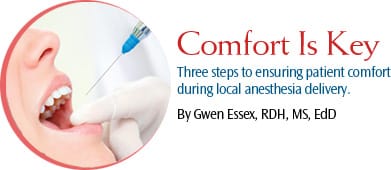
Comfort Is Key
Three steps to ensuring patient comfort during local anesthesia delivery.
According to the 2000 United States Surgeon General’s Oral Health Report, 50% of Americans are afraid of visiting the dental office with one-third so frightened that they avoid seeking any type of oral health care.1 A variety of reasons may contribute to this fear—from a negative childhood experience to embarrassment about the state of their oral health—but the fear of needles or receiving an injection may also be a significant factor.
Dental hygienists know what a difference it makes to keep patients comfortable during treatment, particularly when the use of a local anesthetic is indicated. Patients who are comfortable are much better prepared to benefit from dental hygiene practitioners’ efforts to prevent oral disease, improve their oral health, and provide important oral health education. Patients who have a positive dental experience are more likely to maintain the recommended appointment frequency. Keeping patients comfortable also leads to less stressful treatment appointments for both patients and practitioners.
Maintaining comfort in the dental operatory can present a dilemma. Dental hygienists are obligated to “do no harm” yet the administration of local anesthesia is associated with discomfort.2 However, this literal view would lead to patients never receiving the treatment necessary to maintain oral health. Local anesthesia delivery is a necessary component of effective dental treatment.
Delivering local anesthesia can be daunting if practitioners are unsure of their ability to comfortably deliver the necessary anesthesia—few are happy to cause discomfort in an attempt to control discomfort. However, the following three steps—communication, appropriate use of topical anesthetics, and slow anesthetic delivery—will help practitioners deliver local anesthesia efficiently and confidently while maintaining patient comfort.
1. CLEARLY COMMUNICATE WITH PATIENTS
The first step to easing patient anxiety is effective communication. A foundation of trust can be built by ensuring that patients understand the process of administrating local anesthesia. In particular, practitioners should emphasize the necessary steps being taken to ensure patients’ comfort. By avoiding words with negative connotations, such as “shot,” and “hurt,” and helping the patient anticipate each step in a positive way, the practitioner can build the foundation for a positive, anxiety-free experience.
In addition to preparing patients, practitioners should continually support patients throughout the delivery of the local anesthetic with positive communication. Reminding patients to not hold their breath and to employ abdominal breathing, as well as offering supportive comments, assists in maintaining a positive focus and allays patient anxiety.
2. USE TOPICAL ANESTHETICS
Topical anesthetics are powerful tools in the local anesthesia armamentarium. When used correctly, topical anesthetics are very effective in minimizing patient discomfort from needle penetration. For injections that require the penetration of mucosal tissue, the application of a topical anesthetic provides excellent pain management when applied to dry mucosa and given at least 1 minute of contact time before administering the injection.3 When penetrating keratinized palatal tissue, pressure anesthesia— the creation of ischemia in the tissues through the application of pressure in the area receiving the injection for 1 minute to 2 minutes—should be used.4 Whichever method is indicated by the planned injection, maximizing the effectiveness by allowing enough time ensures patient comfort at the onset of the injection.
3. ADMINISTER LOCAL ANESTHESIA SLOWLY
The last step is to administer the local anesthetic slowly.5 Although it may seem counterintuitive to take time for a procedure that many patients wish would be over in an instant, it is the anesthetic delivery that is most likely to cause patient discomfort. It is generally recommended that 1 minute to 2 minutes be used per 1.8 ml cartridge of local anesthetic to allow for diffusion of the solution, which averts trauma to the patient.5
Practitioners must prepare patients for the amount of time needed to deliver the anesthesia. In absence of an explanation a nervous patient may misinterpret the length of administration as an indication that something is wrong. To avoid this, a practitioner can simply state: “To keep you comfortable, I’m going to go slowly.” This prepares the patient for a slow administration and reminds the patient that the practitioner is concerned about his or her comfort.
In order to be able to effectively administer local anesthesia, proper ergonomics is important. By maintaining an ergonomic position with stable fulcrums and neutral body positioning, the practitioner can comfortably take several minutes to complete the injection. Being safely and comfortably positioned and informing the patient in a supportive manner about the time necessary for the injection sets the stage for a slow and comfortable anesthetic delivery.
CONCLUSION
By communicating with patients, taking advantage of the benefits of topical anesthetics, and administering the anesthetic agent slowly, practitioners can reduce patients’ discomfort during anesthesia delivery. When nontraumatic anesthetic delivery is in the practitioner’s armamentarium, he or she can confidently maintain a comfortable treatment appointment.
REFERENCES
- Oral Health in America. A Report of the Surgeon General. Available at: www.surgeongeneral.gov/library/oralhealth. Accessed December 30, 2009.
- Beemsterboer P. Facing ethical dilemmas. Dimensions of Dental Hygiene. 2009;7(12):44-47.
- Meechan JG. Effective topical anesthetic agents and techniques. Dent Clin North Am. 2002; 46: 759-766.
- Essex G. Update on anesthesia. Dimensions of Dental Hygiene. 2009;7:24-30.
- Blanton PL, Jeske AH. Avoiding complications in local anesthesia induction. J Am Dent Assoc. 2003; 134:888-893.
From Dimensions of Dental Hygiene. January 2010; 8(1): 38, 44, 46.

